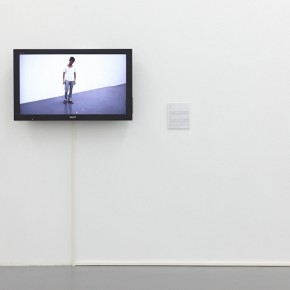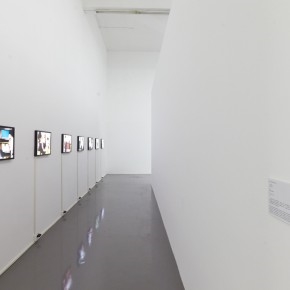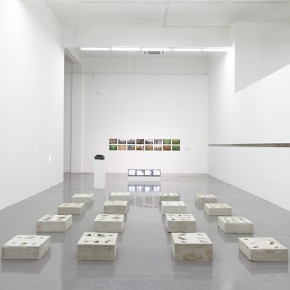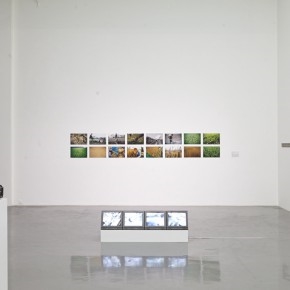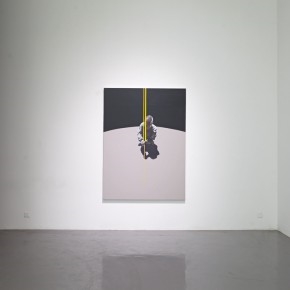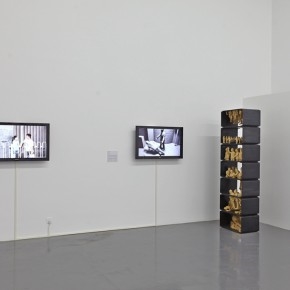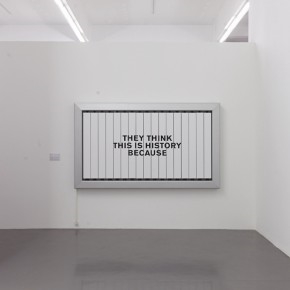
“In my beginning is my end… In my end is my beginning.” T. S. Eliot composed East Coker (1940), the second poem of his renowned Four Quartets (San Diego: Harcourt, 1943), when he was 52 years old. East Coker was the village where Eliot’s ancestors had lived in England before they migrated to the New World. The poem begins with “in my beginning is my end” and ends with “in my end is my beginning”. The concepts of “begin” and “end” have been deconstructed and interlaced, namely the beginning is the end and vice versa, thereby beginning no longer comes before ending, nor does ending comes after beginning. The beginning and the end delimit the reality of universe, which agrees with Stephen Hawking’s remark in A Brief History of Time (New York: Bantam, 1988) “As we shall see, the concept of time has no meaning before the beginning of the universe”. The birth and the death defines the reality of a man/woman, or at least his/her lifetime. Albeit the measurement of time has gone through the evolution of human civilisation over millennia and is now standardised, gauged by second, minute, hour, day, week, month and year, “time” as a concept is abstract still. The interpretation of “time” of an individual may proceed from personal aspects as well as could be influenced by factors such as culture, economy, politics, religion, history, etc.
“Before the Beginning and After the End” at Long March Space exhibits a carefully picked selection of a dozen works by seven artists. Some of the works directly touch upon the concept of “time” while the others, viewed under the subject of “time”, invite new imagination and interpretation on the works.
Chen Chieh-jen's The Route (2006), made for the 2006 Liverpool Biennial, is based on the historic Neptune Jade incident and the global worker's movement. For the video, Chen Chieh-jen (b. 1960) invited members of the Longshoremen's Union of the Port of Kaohsiung to perform a simulated strike.
In the 1980s, all British ports started undergoing systematic privatization under the Thatcher government. Companies assuming control of the ports replaced unionized longshoremen with temporary and non-union labor.
In September of 1995, the Mersey Dock and Harbour Company dismissed twenty Liverpool longshoremen without warning. The company's remaining four-hundred workers immediately banded together, staged a strike and picketed the company. The Liverpool demonstration touched off a global longshoreman's movement against port privatization.
Two years into the strike in September of 1997, non-striking dockworkers at Liverpool Harbor loaded the Neptune Jade, a container ship bound for the Port of Oakland in San Francisco Bay. Workers in Oakland, notified of the Liverpool strike by the International Longshore and Warehouse Union (ILWU), supported the strike by picketing and refusing to unload the ship when it arrived.
Longshoremen in Vancouver, Yokohama and Kobe also joined in supporting the Liverpool strike, and the Neptune Jade was unable to unload its cargo at these various ports around the world. At 12:30 am on October 17, 1997, the ship finally sailed from Kobe to Kaohsiung.
The longshoremen in Kaohsiung never had contact with the ILWU and were unaware of the events surrounding the Neptune Jade. The Kaohsiung Longshoreman's Union had also staged a work stoppage the same year as the Liverpool incident to protest the Taiwanese government's privatization of the loading and unloading of cargo ships. Due to the complexity of local politics and lack of international support, however, this protest did not change privatization policies at the Port of Kaohsiung, resulting in these longshoremen having to accept their status as temporary, day laborers.
After discussing the Neptune Jade Incident with the Kaohsiung Longshoreman's Union and getting their approval, Chen Chieh-jen staged a symbolic strike from August 17 to 19, 2006. Without their employer's knowledge, workers at a private company (a Port of Kaohsiung tenant) helped Chen gain access to a private dock near the port, and it was here, along with an adjacent public area, where filming took place. The film was later exhibited at the Liverpool Biennial, thus initiating dialog with Liverpool residents.
Chen's simulated strike responds to neoliberalism promoted by national governments’ alliances with capitalism, and suggests a course of political action for the future. In making this film, Chen was also concerned with art as a means of extending the outcome of the historic Neptune Jade incident and highlighting its inspirational value and dynamic significance. Chen hopes the incident is not simply relegated to the past just because of its conclusion, and raises questions about how art can continue to develop meaning around the incident after the fact, such that it will continue to occupy the public imagination and experience.
In the video Chen mostly focuses on the expressions and movements of the longshoremen. He deliberately crops out the ocean and port scenery to suggest that as the world’s ports are gradually swallowed up by privatization policies, these areas are waiting to be opened up and seen again.
Special thanks to: The Longshoremen's Union of the Port of Kaohsiung; Kaohsiung City Bureau of Labor; Kaohsiung Museum of Labor Preparatory Office; Labor Video Project, San Francisco, USA; CASA UK.
Note: text courtesy Chieh-Jen Chen Studio
Hu Xiangqian’s Diagram for Speed (2011) records the parallel trajectories of the artist himself and of the electric current.
There is a light switch in Hu Xiangqian’s apartment. The light is distant from the switch, but it turns on the instant the switch is flipped.
“How fast does electricity travel?”
Hu Xiangqian (b. 1983) carried out a performance thereupon in 2011. He equipped the locale with a racetrack and set up a frame structure around which a several-kilometre electric wire was coiled; a switch was connected to the wire at one end and an electric bulb at the other. The starter flipped the switch and pulled the trigger simultaneously, and Hu Xiangqian got off at the sound of the pistol and sprinted towards the bulb. The audience saw that the bulb turned on immediately, but Hu Xiangqian lagged behind. The process of Hu Xiangqian’s movement and the bulb’s brightening, which covered merely twenty metres and lasted for less than three seconds, was tracked with the method of time-lapse photography; over a hundred photographs were generated at last, and the interval time between two successive photos was less than 0.02 second.
Hu Xiangqian expounds that, “From A to B, from the beginning to the end, there lies an eternal space and distance. No matter how fast electricity travels, it moves from A to B, from the beginning to the end. I am fascinated by the space and the speed, which I think are something alluring. I also moved from the beginning to the end, catching such speed with the movement of my body, and I hope the audience can feel the beauty of speed in this way, too.”
Hu Xiangqian’s Within One Meter (2011) is a set of seven film stills, presented in seven light boxes. The artist notes that, “this project is inspired by the common soap opera shown on TV.”
Hu Xiangqian (b. 1983) is fascinated by the so-called “common soap opera”, the recreation of the mass. A soap opera contains many signifiers that one can easily pick up from, e.g. the climaxes that are equally distributed according to the intervals for commercials, the mode of storylines, the costume and makeup of the cast members, the stage properties, stage settings and lines. The term “soap opera” comes from the United States, but its established pattern renders it so replicable that it becomes a universal visual language of the popular culture.
Hu Xiangqian wrote a script, recruited actors and mounted the stage set and lighting for this work. He himself appeared in the performance of the soap opera and made a soap opera-esque video. At last, he selected seven stills that illustrate the entire story, and each blank between two successive photos represents what the artist edited out and considered needless. In other words, Within One Meter is a complete soap opera though it is only made up of seven photos, for it is only these seven “moments” that the director deems necessary to tell the story.
Note: the work is titled Within One Meter because the artist thinks the actors in soap operas are no more than one metre away from one another in most cases.
Ran Huang’s Something as Beautiful, as Desirable, as Transcendent, as Evil (2011) is a looped slide show. Ran Huang (b.1982) appropriates the film that documents the Space Shuttle Challenger disaster in 1986, adopting excerpts of the space shuttle immediately before, during and after its explosion, and produced a work consisting of forty slides.
The Space Shuttle Challenger disaster occurred in 1986, when the shuttle broke apart 73 seconds into its flight, leading to the deaths of its seven crew members. Approximately 17 percent of Americans witnessed the launch live because of the presence of one crew member who was the first member of the Teacher in Space Project. One study reported that 85 percent of Americans surveyed had heard the news within an hour of the accident. This incident resulted in a 32-month hiatus in the shuttle program.
The Space Shuttle Challenger disaster has become part of the collective memory of the country, and the explosion is deemed inseparably linked with trauma, fright and confusion. It was precisely to distinguish the film of explosion and the fact of calamity from the huge impact it resulted in that Huang Ran employed the means of a slide show as the medium. Ran Huang’s Something as Beautiful, as Desirable, as Transcendent, as Evil is continuous yet fragmented likewise. When the process of the explosion is shown slide by slide with the noise of the machine and the freeze-frame, the viewers are presented with the purity of the imagery, separate from what it represents, albeit only momentarily.
Ran Huang’s Mute (2014) is a sentence with no full stop—“this is history, because”. When repeated constantly, the sentence becomes complete, but it enters an endless loop without providing any information—“this is history, because this is history, because this is history, because…” Ran Huang (b.1982) carries out a “circular argument” on a tri-vision display billboard normally used for road-side advertisement; a theory is played back repeatedly… and circular argument is a self-referential methodology—“A is real, because B is real; B is real, because A is real.” Are both A and B real? Or is neither A nor B real?
Wang Jianwei’s Circulation – Sowing and Harvesting (1993-1994) is a set of sixteen photographs, documenting the following: Wang Jianwei (b. 1958) collaborated with a local farmer in early 1990s. The farmer provided an area of land and Wang Jianwei provided a new species of wheat seeds; the farmer sowed the seeds, and he shared the risks and benefits with Wang Jianwei. Wang Jianwei documented the entire process with a camera of raising the wheat, including sowing in autumn, planting seeds, applying fertiliser and pesticide, weeding, watering, and harvesting in the following summer. Wang Jianwei remarks that “This piece is no photography. The images don’t have to be clear and sharp; they just record an event.”
Wang Jianwei’s Gaze (2009) is a video work where characters from different times and different spaces assemble on the same stage. The opening shot resembles a figurative painting of the Northern Song Dynasty. Five groups of characters dressed in Song or Ming costumes are playing various musical instruments, drinking wine and playing Chinese chess…, but the tableau is static, except for a breeze blowing through the stage grazing the hair and costume of the performers. After a while they start to move, conducting recreational activities. Then characters in Qing costumes appear on stage, and characters in Minguo costumes, in modern costumes… the stage is gradually filled with characters and activities from different times. At a signal, all movements stop and the static state recovers.
Wang Jianwei (b. 1958) remarks that, “contemplation and liberation, narration and presentation, they constitute the varied spatial ways we view a work (film, drama, exhibition) and meanwhile are limited within the control of time. Time dominates our viewing on one hand and immures us in different ‘exactitudes’ on the other. We have been fastened to the patterns of respective artistic modes.”
Wang Sishun’s All the Flesh Is with Remorse (2012) consists of two parts. In the first part, Wang Sishun (b.1979) filmed the pavement under Dashanzi Bridge with a full-length shot, and the video was shown at the artist’s solo exhibition “Liminal Space” at Long March Space in 2012. In the afternoon on the opening day, the audience followed the artist to Dashanzi Bridge, and the circumstance on the pavement opposite was very similar as what was shown in the video in the gallery. The only difference was that the “circumstance” was a performance. The artist deliberately cast actors who bore physical resemblance to the people in the video, dressed them in the identical attire, and had them act out the scene captured in the video. This “performance” became the second part of the work. This is the first time the piece is shown in its entirety, including both the first and the second parts.
Wang Sishun remarks that, “there is no time, no beginning and no end. The stage-like setting under the bridge together with traffic and noise creates a rough medium, which is bewildering and alienating. It seems as if the incident has happened to ourselves, or we have seen it before, like in our previous existence. Therefore, our imagination is no longer a metaphor, and the reality becomes rhetoric. Screened off by the traffic, the self is on the opposite side; this melancholy belongs to the city.”
Wang Sishun’s Desire and One of N Points (2012) derives from a performance with no audience. The artist randomly threw a bottle cap on the gallery floor and drew a circle around the cap; he then picked up the cap and repeated the action of aiming and shooting until the cap landed in the circle. This performance was recorded on video, wherein the artist and his continual efforts are shown. The shots were taken from the same angle, capturing the same person doing the same thing repeatedly, and the only few edits took place when the artist left the scene. The performer (i.e. the artist), the cap and the circle on the floor were connected by a repeated action; the action lost its sense bit by bit while the devotion, frustration, boredom, exhaustion and other physical and emotional reactions gradually sufaced. How the performance ends is pre-determined (cap in the circle), and the only unpredictable factor is when it ends; the most surprising part of the piece is also at its very end.
Wang Sishun (b.1979) remarks that, “the world is an immense formula, and we are being determined. Underneath the surface of the trivia, there is an algorithm that is bigger than the world as we know it. Probability is the most effective and sufficient description of uncertainty, and the destiny of the algorithm is resolute yet uncertain.”
Note: The performance this video piece documented took place in June, 2012, at Long March Space. It was at this spot where currently the video is being shown that the artist personally carried out the performance.
Xu Zhen’s Decoration (2008) is a four-channel video, and it derives from the eponymous performance and installation work at the artist’s last solo exhibition before he established MadeIn Company. In 2008, Xu Zhen (b.1977) set up a life-sized spacecraft in the gallery of Long March Space, wherein a man and a woman lived for twenty-one days. Four cameras were installed within the capsule, and goings-on in the spacecraft were broadcast live with closed-circuit television. In the gallery, viewers could only see the exterior of the spacecraft and what the four CCTVs showed, without seeing the circumstances inside the capsule. The spacecraft as an object was “real”, yet it was a fake spacecraft that was not built to function. It was a fabricated reality inside the capsule; a man and a woman simulated astronauts’ mode of life, and they meticulously lived and worked in the capsule for twenty-one days. However, the only evidence that somewhat could be viewed as proof that the parallel reality inside the capsule existed simultaneously like a performance was the video streams on the CCTVs and their ever-changing time stamps.
Xu Zhen’s “Revolution Castings” (2012) derives from a social activity initiated by the artist. Xu Zhen (b.1977) recruits stones, an iconic material used for resisting in all kinds of events of conflict, and cast each of them with traditional casting techniques. The moulds are kept and exhibited. The artist attempts to revive and sustain the strength and passion of resistance. This is a movement serving as a continuation to the movements before it, documenting and reproducing the instinct of resistance in human history.
Note: the Revolution Castings series (2012) is produced by MadeIn Company.
Zhou Xiaohu’s Montage Structure (2010) is a short clay animation film. Film is an art form that is time-based, and montage is a major technique of narration and expression for cinematic creations. The definition of montage varies depending on film industries in different regions and the history. Sergei Eisenstein marked a note saying montage is “the nerve of cinema”, and that “to determine the nature of montage is to solve the specific problem of cinema”. Zhou Xiaohu (b.1960) also made an unspecific but objective point that “montage is an idea that arises from the collision of independent shots” wherein “each sequential element is perceived not next to the other, but on top of the other.” Thus, the concept of collage has been brought into filmmaking via montage. If every shot is an independent individual, when different shots collaged in a certain way will produce a connotation that every single shot does not bear when separate.
Montage Structure demonstrates a typical technique of montage. The two storylines, one of the assassin and the other of the victim, are intertwined, and the concise editing of short shots intensifies the pace of the film, keeping the viewers on the edge of their seats.
About the exhibition
Duration: Sep 2, 2014--Nov 2, 2014
Venue: Long March Space
Artists: Chieh-Jen Chen, Hu Xiangqian, Ran Huang, Wang Jianwei, Wang Sishun, Xu Zhen, Zhou Xiaohu
Courtesy of the artists and Long March Space.


